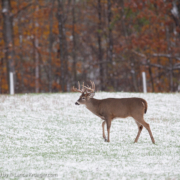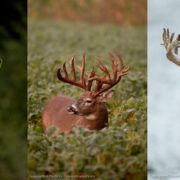Find the Best Late Season Deer Hunting in Ohio
Tips for Late Season Deer Hunting
Late season deer hunting is one of those things that can really separate people. After all, it can be a very challenging time to hunt whitetails. Freezing weather, hammering winds, and snow are all an increasing possibility the later in the season that you hunt, and nobody likes to hunt in those conditions, no matter what they tell their friends. At the same time, deer have likely been hunted and pressured for weeks or even months of the deer hunting season, which can put them on high alert – that is especially true with mature bucks. But there is an upside. In the right areas, on the right properties, and using the right hunting tactics, you can be successful hunting deer in the late season. Here’s why that’s especially true in Ohio, and here at Briarwood Sporting Club.
Why Ohio for Late Season Deer Hunting?
Honestly, it’s the same answer for hunting deer any other time of the year. Ohio has the perfect mix of habitat and food for whitetails to thrive and reach their full potential. Overall, there is a large amount of food in the form of row crops (primarily corn and soybeans), which fuel the body size and antler growth you’d expect from such an area. Mixed in with these agricultural fields are stretches of mixed hardwood forests (e.g., oaks, maples, hickory, etc.). These woods offer hard mast in the fall and good cover the rest of the year. In rolling terrain, the forested slopes also provide excellent bedding opportunities surrounding the flat ag fields.
One potential benefit to late season Ohio deer hunting is also a drawback. Most of Ohio consists of private land – that can be good in the fact that many adjoining landowners can join together in a cooperative to let the deer herd grow to a higher standard (i.e., bigger bucks), but the downside is that it can be tough to find a public hunting spot or get permission on private land. Fortunately, the Briarwood Sporting Club provides the best of both worlds.
Late Season Deer Hunting Tips
With all that said, here are several late deer season tips that you can utilize almost anywhere. But they’re especially helpful in Ohio and here on our own property, whether you choose open range or guided deer hunts.
- Focus on evening food. It usually pays off to focus on food sources (e.g., picked ag fields, standing corn/beans, etc.) and the best time of day to hunt late season deer is definitely the evening. After the rut, bucks are weary and need food, and the colder weather tends to get them on their feet earlier in the afternoons. Positioning yourself on one of these field edges could be the ticket to encountering a giant buck in the late season.
- Hunt in covered/enclosed blinds if possible. Mature bucks have likely been harassed a bit throughout the fall, and may be a bit spooky. The more you can hide your silhouette, scent, and sounds, the better chance you have of actually pulling the trigger on a big deer.
- Head to the cover in heavily pressured areas. In some areas of Ohio where you see a lot of public or private hunting pressure, deer may avoid open fields in daylight and prefer to stick to the thick cover. Edging in closer to bedding areas and traditional sanctuary areas could be risky, but not for late season deer hunting when you don’t have much time left anyway.
- Give up the late season deer calling and scents. In most places, the bucks have seen and heard it all up to this point, and might get skittish about it. It’s better to rely on a good tree stand or blind position instead.
- Get mobile. If you’re doing some late season big woods deer hunting with a lot of room to roam, consider tracking and stalking a buck instead. You can sometimes sneak right up on them if the conditions are right.
If done the right way using the tips above, late season deer hunting can be a great way to get a shot at a mature buck of a lifetime.

Why Briarwood?
That brings us to the next point. Why consider hunting at Briarwood Sporting Club? As we said, it can be hard to get access to hunting land in our state, but we have access to our own amazing property and several others nearby. We have two options for whitetail deer hunting. You can choose to hunt open range deer on one of the local properties in Logan County to which we have exclusive hunting rights. Or you can go on guided whitetail deer hunts right here on our estate. The open range properties offer a wonderful mix of habitat and food, and you have a great chance at harvesting a deer on one of them. Our own trophy whitetail estate offers you the rare chance to encounter 200+ inch whitetails, which is unheard of in most of the country, making us an amazing deer hunting outfitter choice.

Chris with a 160 4/8’s free range ohio late season buck from Briarwood.
How Did This Late Season Hunt Go Down?
- Nov. 17- Chris found Briarwood by searching for “open range whitetail hunt in Ohio” and immediately requested the open range packet.
- Nov. 19- The packet is sent and Chris is contacted shortly after. Chris wanted to hunt during Ohio’s firearms season on Nov. 26. We already sold out of Ohio open range gun season hunts so we booked him for a late season hunt during Dec. 12-16.
- Dec 13th, the evening of the second day of his hunt, Chris scores this 160 inch buck!








